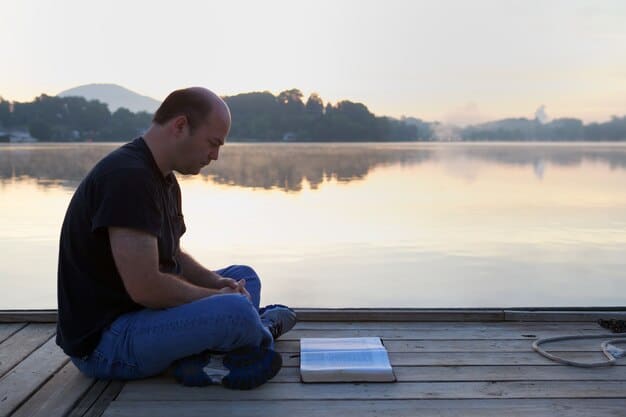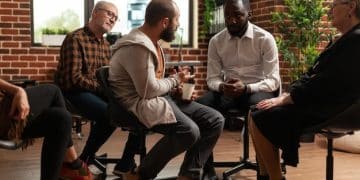988 Lifeline & Men’s Mental Health: 2025 Impact Analysis

The 988 Suicide & Crisis Lifeline significantly influences men’s mental health in 2025 by offering an accessible, confidential, and destigmatized pathway to support, potentially increasing help-seeking behaviors among a demographic historically reluctant to engage with traditional mental health services.
The landscape of mental health support is continually evolving, with significant strides being made in accessibility and awareness. A pivotal development in this realm is the establishment of the 988 Suicide & Crisis Lifeline. Understanding exactly how does the new 988 Suicide & Crisis Lifeline impact men’s mental health in 2025 requires a thoughtful examination of its design, reach, and the unique challenges faced by men in seeking mental health assistance.
Understanding the 988 Lifeline: A New Era of Crisis Support
The 988 Suicide & Crisis Lifeline, launched in July 2022, represents a transformative shift in how mental health crises are addressed in the United States. It provides a simple, memorable three-digit number for individuals experiencing a mental health crisis, offering a direct link to a network of trained crisis counselors. This initiative was designed to be the mental health equivalent of 911, aiming to provide immediate, confidential support and de-escalation, diverting calls away from emergency services when appropriate.
This accessibility is crucial, particularly for populations that often struggle to navigate complex healthcare systems or feel burdened by the stigma associated with seeking mental health help. By establishing a universal, easy-to-remember number, 988 seeks to remove barriers, ensuring that help is just a phone call or text away, 24 hours a day, 7 days a week. The underlying philosophy is to offer compassionate, non-judgmental support, fostering an environment where individuals feel safe to express their distress.
The Genesis and Goals of 988
The concept of 988 emerged from a recognition of the growing need for a dedicated mental health crisis line. Traditional emergency numbers often lead to law enforcement or hospital interventions, which may not always be the most appropriate or helpful response for someone in a mental health crisis. The goal of 988 is to provide an immediate, dedicated mental health response that can often de-escalate situations, provide referrals, or simply offer a supportive ear. It aims to reduce the burden on emergency services while providing more effective and humane care.
Key objectives of the 988 Lifeline include:
- Universal Accessibility: Providing an easy-to-remember number for anyone in mental health distress.
- Timely Intervention: Offering immediate support to de-escalate crises and prevent further harm.
- Resource Connection: Linking individuals to ongoing mental health care and community services.
- Reduced Stigma: Normalizing help-seeking for mental health challenges by offering a discreet and confidential pathway.
The infrastructure supporting 988 relies on a network of existing crisis centers nationwide, bolstering their capacity and ensuring consistent service delivery. As 2025 approaches, the system is expected to be more robust, with enhanced training for counselors and improved integration with local mental health resources, further solidifying its role as a vital component of the mental health ecosystem.
Men’s Mental Health Before 988: A Landscape of Silence and Stigma
Before the advent of 988, the landscape of men’s mental health in the United States was, and to some extent remains, characterized by significant challenges rooted in societal expectations and deeply ingrained cultural norms. Traditional masculinity often dictates emotional stoicism, self-reliance, and a reluctance to express vulnerability. These expectations can create formidable barriers for men experiencing mental health struggles, often leading to delayed diagnosis, untreated conditions, and, tragically, higher rates of suicide compared to women.
The Silent Struggle: Societal Pressures on Men
Men are frequently conditioned from a young age to suppress emotions, “tough it out,” and avoid anything perceived as weakness. This cultural scripting can manifest in various ways, from downplaying symptoms of depression and anxiety to avoiding conversations about emotional well-being altogether. The pressure to be a provider, strong, and in control can be immense, making the act of admitting a struggle with mental health feel like a failure. This can lead to a cycle of internalizing distress, resorting to unhealthy coping mechanisms, or self-medicating, rather than seeking professional help.
Consider the prevailing narrative: a man is expected to be resilient, capable of handling his own problems. When faced with anxiety, depression, or suicidal ideation, this expectation becomes a heavy burden. The fear of being seen as “less than” can be a powerful disincentive to reaching out, even to loved ones. This silent struggle is often exacerbated by limited male-friendly mental health resources and a healthcare system that, historically, has not always been attuned to the specific ways men express distress.
Barriers to Access and Help-Seeking
Several tangible barriers have historically prevented men from accessing mental health support:
- Stigma and Shame: A pervasive belief that seeking help for mental health is a sign of weakness, leading to feelings of shame.
- Lack of Awareness: Many men may not recognize their symptoms as indicative of a mental health condition, or they might attribute them to stress, fatigue, or other physical ailments.
- Limited Male-Friendly Services: A perceived lack of mental health services tailored to men’s specific needs and preferences.
- Logistical Challenges: Busy schedules, work demands, and a lack of readily available appointments can deter men from prioritizing their mental health.
- Reluctance to Discuss Emotions: A learned inability to articulate feelings and emotional states, making therapy or counseling seem daunting.
These pre-existing conditions highlight the critical need for a service like 988, which aims to bypass many of these traditional barriers and offer a direct, immediate, and less intimidating entry point into mental health support. The hope is that by 2025, the familiarity and ease of 988 will have significantly altered these help-seeking patterns among men.
The Direct Impact of 988 on Men’s Accessibility to Mental Health Support
The introduction of the 988 Suicide & Crisis Lifeline has ushered in a new era of mental health accessibility, particularly for populations like men who have historically exhibited lower rates of help-seeking. By offering a single, easy-to-remember number, 988 significantly reduces the cognitive and emotional load associated with finding support during a crisis. This streamlined access is a crucial factor in encouraging men to reach out when they might otherwise hesitate. The simplicity of dialing three digits eliminates the need to navigate complex directories or explain a situation repeatedly, which can be a deterrent for individuals already feeling overwhelmed.
One of the most immediate impacts is the potential to bypass the traditional gatekeepers of mental health care. Instead of requiring a referral from a primary care physician, which can be a multi-step process, 988 offers direct access to a trained crisis counselor. This direct line can be especially appealing to men who may prefer a more anonymous and immediate form of support, free from the perceived judgment or bureaucratic hurdles often associated with conventional healthcare pathways. The anonymity offered by a phone or text conversation can lower inhibitions, allowing men to articulate their struggles more freely than in a face-to-face setting.
Overcoming Barriers Through Simplicity and Confidentiality
The design of 988 directly addresses several key barriers that have historically prevented men from seeking mental health support. The simplicity of the number itself is a powerful tool against inertia. In moments of acute distress, the ability to quickly recall and dial 988 can make the difference between reaching out and succumbing to despair. This ease of access is particularly important for men, who, as noted, may feel pressured to project an image of self-sufficiency.
Furthermore, the emphasis on confidentiality and non-judgmental support within the 988 system is vital. Men are often hesitant to discuss their emotional vulnerabilities for fear of being perceived as weak or inadequate. Knowing that the conversation will be confidential and handled by a trained professional who understands crisis intervention can significantly reduce this apprehension. The ability to engage in a conversation without revealing one’s identity unless necessary, and sometimes through text, offers an alternative for those who find verbalizing their emotions particularly challenging.
The direct access to a crisis counselor, rather than immediate engagement with law enforcement or emergency medical services, also redefines the response to mental health crises. For many men, the fear of legal repercussions or forced hospitalization can deter them from seeking help. 988 aims to de-escalate situations and provide appropriate support in the least restrictive environment possible, preserving dignity and autonomy. By 2025, the increased awareness and successful outcomes through 988 are likely to further normalize and encourage this pathway for men in distress.
Shifting Perceptions: How 988 Works to Destigmatize Mental Health for Men
The inherent design and public messaging surrounding the 988 Suicide & Crisis Lifeline actively contribute to the ongoing efforts to destigmatize mental health, especially for men. By positioning mental health crises as a public health issue rather than a personal failing, 988 reconfigures the narrative. It normalizes the act of seeking help during a period of distress, framing it as a brave and proactive step towards wellness, rather than an admission of weakness. This subtle yet powerful reframe is crucial for men, who are often burdened by societal expectations of stoicism and self-reliance.
The presence of a universally recognized crisis number, akin to 911 for physical emergencies, validates the severity and legitimacy of mental health struggles. It sends a clear message that mental distress is a serious concern that warrants immediate, professional attention, just like a physical injury or a medical emergency. This institutional endorsement of mental health as a critical health component helps dismantle the notion that these issues should be privately endured or hidden. For men, who may feel isolated in their struggles, this public validation can be incredibly empowering, encouraging them to step out of the shadows.
Normalizing Help-Seeking Through Public Awareness and Empathy
Extensive public awareness campaigns promoting 988 play a pivotal role in this destigmatization process. As the number becomes more widely known and its purpose understood, talking about mental health, including reaching out for support, becomes less taboo. These campaigns often highlight stories of recovery and resilience, showcasing that mental health challenges are common and treatable. When men see public figures or peers openly discussing their reliance on support systems, it can inspire them to do the same.
The empathetic and non-judgmental approach inherent in 988’s crisis counseling further reinforces this shift. Counselors are trained to listen, validate feelings, and provide support without imposing judgment or shame. This approach creates a safe space for men, who might otherwise fear being misunderstood or dismissed. The emphasis on compassionate listening helps to break down the emotional barriers that often prevent men from opening up about their vulnerabilities.
Key elements of 988’s destigmatization strategy include:
- Legitimizing Crisis: Treating mental health crises with the same urgency and seriousness as physical emergencies.
- Promoting Confidentiality: Ensuring privacy to reduce fear of social or professional repercussions.
- Universal Availability: Making help accessible to everyone, irrespective of social status or background, reducing perceived elitism in mental health care.
- Public Education: Raising awareness that mental health challenges are treatable and that seeking help is a sign of strength.
By 2025, the sustained presence and promotion of 988 are expected to have a profound cumulative effect on societal perceptions, fostering an environment where men are more comfortable discussing their mental health and seeking the help they need without fear of judgment.
Potential Challenges and Limitations for Men’s Engagement with 988
While the 988 Suicide & Crisis Lifeline holds immense promise for improving mental health outcomes, particularly for men, it is not without its potential challenges and limitations. These factors, if not adequately addressed by 2025, could impede the full realization of 988’s impact on male populations. A critical consideration revolves around the deeply ingrained cultural factors that contribute to men’s reluctance to seek help, which even a simplified access point may struggle to entirely overcome.
One significant challenge stems from societal norms of masculinity. Despite the increased accessibility of 988, many men may still find it difficult to initiate a call due to persistent beliefs that expressing vulnerability or admitting to mental distress is a sign of weakness. The act of reaching out, even anonymously, can clash with internalized expectations of self-reliance and emotional stoicism. This “macho” image, however outdated, continues to influence behavior, potentially leading men to endure suffering in silence rather than dialing for help.
Addressing Varied Needs and Ensuring Adequate Resources
Another limitation lies in the potentially varied needs of men and the capacity of the 988 system to consistently meet them. While 988 provides immediate crisis support, some men may require more specialized or prolonged therapeutic interventions that 988 is designed to refer to, but not directly provide. The quality and availability of these downstream services, particularly those that are male-friendly or culturally competent, will be critical. If referrals lead to long waitlists or unsuitable options, the initial positive engagement with 988 might not translate into sustained mental health improvement.
Consider these potential limitations:
- Cultural Resistance: Persistent adherence to traditional masculine ideals that discourage emotional expression and help-seeking.
- Resource Strain: The ability of local crisis centers to keep pace with increased call volume and provide timely, effective referrals.
- Varied Preferred Communication: While 988 offers text, some men might prefer a different type of initial engagement beyond phone or text, or require specific male-centric approaches.
- Follow-up and Continuum of Care: Ensuring that initial crisis intervention seamlessly transitions into ongoing support for those who need it.
The success of 988 by 2025 hinges not just on its ability to connect individuals to help, but also on the strength of the underlying mental health infrastructure to absorb and support the increased demand. For men, this means ensuring that the options provided after the initial 988 contact are relevant, accessible, and culturally sensitive. Furthermore, ongoing societal shifts are necessary to complement 988’s efforts in truly breaking down the stigma that still envelops men’s mental health.

The Future Outlook: Prognosis for Men’s Mental Health in 2025 with 988
As we look towards 2025, the prognosis for men’s mental health in the context of the 988 Suicide & Crisis Lifeline is cautiously optimistic, yet contingent on several critical factors. The national rollout and growing visibility of 988 have already begun to lay the groundwork for a more accessible and destigmatized approach to mental health support. By 2025, it is reasonable to expect an increased awareness among men, making 988 a more familiar and perhaps less intimidating resource. This familiarity, coupled with consistent, positive messaging about seeking help, could slowly chip away at the long-standing cultural barriers.
The hope is that by 2025, 988 will be so ingrained in the public consciousness that contacting it becomes a normalized response for men facing mental health crises. This normalisation extends beyond just calling the line; it also encompasses a broader acceptance within male peer groups and families that seeking mental health support is a sign of strength and self-care, not weakness. Success metrics for 988 in relation to men’s mental health will likely include increased call volumes from male callers, a reduction in suicide attempts among men, and a greater engagement with follow-up mental health services facilitated by 988 referrals. The focus will shift from just crisis response to active prevention through early intervention.
Measuring Success and Areas for Continued Improvement
The true impact of 988 on men’s mental health will be measured not only by the number of calls but also by the quality of interventions and the successful connection to ongoing care. Key indicators of progress will include:
* Increased Male Utilization: A significant rise in calls and texts from men, especially those who traditionally would not have sought help.
* Referral Efficacy: The seamless transition of men from crisis calls to appropriate follow-up care, including therapy, support groups, or medication management.
* Reduced Stigma: Longitudinal studies showing a measurable decrease in the self-stigma associated with mental health issues among men.
* Specific Outreach: The development of targeted outreach campaigns by 988 and its partners that specifically address men’s unique challenges and communication styles.
By 2025, the synergy between 988’s accessible immediate support and a more robust downstream mental health referral network is critical. This means ensuring that local and regional mental health providers are equipped and responsive to the specific needs of men, offering diverse therapeutic approaches and culturally competent care. The success of 988 is not a standalone achievement; rather, it’s a testament to a broader ecosystem of mental health support that needs continuous funding, training, and public awareness. Continued innovation in outreach methods, perhaps leveraging digital platforms and peer support networks more extensively, will also be vital in ensuring that 988 reaches every man who needs it. The coming years will be crucial in solidifying 988’s role as a cornerstone of men’s mental health support.
Beyond the Call: Integrated Approaches Complementing 988 for Men
While the 988 Suicide & Crisis Lifeline stands as a monumental step forward, its effectiveness for men’s mental health in 2025 will be significantly enhanced by integrated, comprehensive approaches that extend beyond the initial crisis call. A single access point, no matter how efficient, cannot solve the multifaceted issues contributing to men’s mental health challenges. For sustained improvement, 988 must operate within a broader ecosystem of support that acknowledges the unique aspects of male psychology and societal pressures.
One critical complementary approach involves fostering male-specific mental health programs. These could include therapy groups tailored to men, designed around shared experiences such as career stress, fatherhood, or relationship issues, offered in environments that feel less intimidating than traditional clinical settings. Furthermore, integrating mental health screenings into routine healthcare visits for men, such as annual physicals, could help identify issues early before they escalate to crisis levels. This proactive approach normalizes the discussion of mental well-being in a familiar, less stigmatized context.
The Role of Community, Workplace, and Digital Platforms
Community-based initiatives and workplace wellness programs also play a crucial role in complementing 988. Workplaces can become vital spaces for destigmatizing mental health by promoting open dialogue, providing mental health resources (including awareness of 988), and fostering supportive environments. Peer support networks, particularly those led by men, can create safe spaces for sharing experiences and offering mutual encouragement, reinforcing the idea that vulnerability is not a weakness.
Digital platforms and telehealth services represent another powerful complement. While 988 offers phone and text support, the expansion of online therapy, well-being apps, and discreet mental health resources can cater to men who prefer asynchronous communication or who are geographically isolated. These platforms can offer a sense of control and privacy, which are often highly valued by men. By 2025, the synergy between 988 and these broader initiatives will be key:
- Targeted Outreach: Developing campaigns that speak directly to men’s experiences and challenges.
- Workplace Wellness: Encouraging employers to integrate mental health support and awareness into their corporate culture.
- Peer Support Networks: Facilitating male-led groups where men can share and connect in a low-pressure environment.
- Digital Health Solutions: Expanding access to online therapy, self-help apps, and virtual support groups that offer flexibility and anonymity.
Ultimately, the full impact of 988 on men’s mental health by 2025 will depend on its ability to serve as a gateway to a comprehensive, integrated, and male-sensitive network of care that addresses immediate crises while also promoting long-term well-being and resilience.

Addressing Policy and Funding to Sustain 988’s Impact on Men’s Mental Health
The long-term impact of the 988 Suicide & Crisis Lifeline on men’s mental health in 2025 and beyond hinges significantly on sustained policy support and robust funding. While the initial launch and growing awareness are commendable, the continuous effectiveness of 988, especially in reaching specific populations like men, relies on the political will to maintain and expand its capabilities. Without consistent financial backing and strategic policy frameworks, the service risks becoming overwhelmed, understaffed, or unable to adapt to evolving needs.
Federal and state policies play a pivotal role in ensuring that 988 is adequately resourced and integrated into the broader healthcare system. This includes dedicated funding streams that allow crisis centers to hire and train sufficient personnel, implement advanced call routing technologies, and provide comprehensive follow-up services. For men, this means ensuring that their calls are answered promptly, that counselors are equipped to understand male-specific challenges, and that referrals lead to accessible and appropriate care settings. Policies also need to support ongoing research into effective interventions for men’s mental health, feeding insights back into the 988 system to refine its approach.
Ensuring Equity and Quality of Care for All Men
Beyond just funding numbers, policy must also address equity. This involves ensuring that 988 services are universally accessible across diverse male demographics, including men from rural areas, LGBTQ+ men, veterans, and minority groups, who may face additional barriers to care. Policies promoting cultural competence training for 988 counselors are essential to ensure that interactions are effective and non-stigmatizing for every caller.
Key policy and funding considerations include:
- Sustainable Funding Models: Establishing long-term financial commitments at federal and state levels to ensure operational stability and growth.
- Workforce Development: Investing in training and retaining skilled crisis counselors, including those specialized in men’s mental health.
- Data-Driven Improvements: Utilizing call data and outcomes to continually refine service delivery and target specific needs within male populations.
- Care Continuum Integration: Policies that facilitate seamless transitions from 988 crisis intervention to ongoing mental health treatment.
By 2025, strong policy frameworks and sustained funding will solidify 988’s role not just as an emergency hotline, but as a foundational pillar of a proactive and responsive men’s mental health strategy. This strategic investment is crucial for transforming the mental health landscape for men, moving from crisis reaction to holistic prevention and support.
| Key Point | Brief Description |
|---|---|
| 📞 Enhanced Access | 988 offers an easy, confidential 3-digit number, bypassing traditional barriers to mental health support for men. |
| 👨🦰 Destigmatization | Public awareness of 988 legitimizes mental health crises, encouraging men to seek help without shame. |
| 🚧 Persistent Challenges | Societal norms of masculinity and resource limitations remain hurdles for 988’s full impact on men. |
| 💡 Integrated Support | 988’s success is amplified by male-specific programs, workplace wellness, and sustained funding. |
Frequently Asked Questions About 988 and Men’s Mental Health
988 offers immediate, confidential, and anonymous support, which can be less intimidating for men who might traditionally avoid face-to-face therapy due to stigma or perceived vulnerability. Its simplicity removes common barriers to seeking help during a crisis.
By establishing a national, easy-to-remember crisis line, 988 normalizes mental health crises as public health issues, showing they warrant professional attention. Public awareness campaigns also challenge societal norms, encouraging men to view help-seeking as a sign of strength.
Yes, 988 is designed to provide not just immediate crisis support but also referrals to ongoing mental health care, local resources, and community services. The aim is to bridge the gap between acute crisis and sustained well-being for men.
Key challenges include overcoming deeply ingrained cultural norms of masculinity, ensuring sufficient funding for crisis centers, the availability of male-sensitive downstream services, and effectively reaching diverse populations of men. Continued outreach and resource-building are vital.
Workplaces can promote mental wellness programs and destigmatize discussions, while communities can foster peer support groups and accessible, male-friendly mental health services. These integrated approaches amplify 988’s reach and provide a holistic support system for men.
Conclusion
The advent of the 988 Suicide & Crisis Lifeline marks a pivotal moment in the evolution of mental health support, particularly for men. By 2025, its impact on men’s mental health is projected to be significant, offering an accessible, confidential, and destigmatizing pathway to crisis intervention and ongoing care. While challenges remain due to societal norms and resource demands, 988 serves as a crucial catalyst in fostering an environment where men are increasingly empowered to seek help without shame. Its continued success hinges on sustained funding, policy support, and the integration of broader community and workplace initiatives, ensuring that every man has the opportunity to prioritize his mental well-being.





